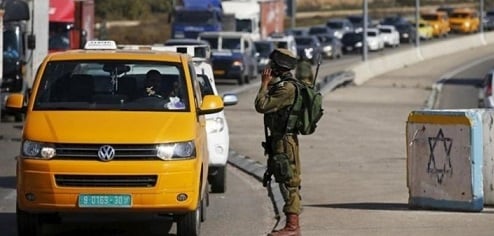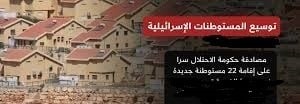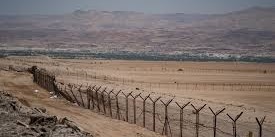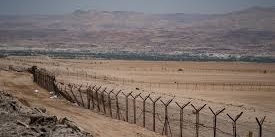By: Madeeha Al-A’raj
The national Bureau for Defending Land and Resisting Settlements stated in its latest weekly report , that last week, the settlers’ leaders sent a letter to the inner Israeli cabinet in which they demand a fundamental change in dealing with Palestinians in the West Bank (e.g. the elimination of what they called the ‘terrorist infrastructure’ through displacing Palestinian residents in areas that support ‘terror’, then entering and cleansing them, as is the case in Gaza, and to change traffic roads in the West Bank, deploy more checkpoints, not to keep security in the Palestinian Authority’s hand as (it has turned into a real army). Within the context, Ben Gvir has returned to incite against the Palestinian people, where he wrote on the X website more than once that the settlers’ right to life is a priority over the Palestinians’ freedom of movement.
The settlers’ leaders and their government are obsessed by the demon of closing the relationship with the Palestinians to a security circle, and the security approach that they want to change in dealing with Palestinian citizens is, complementary in its brutality to the criminal practices carried out by the Jewish terrorist organizations operating in the settlements, outposts and so-called pastoral farms against the Palestinians in C areas. They are not satisfied with the barriers, barriers and concrete cubes that are spread throughout the West Bank, which exacerbate the daily suffering of the Palestinians, but demanding more an more of them to achieve the goal of influencing the daily life of the Palestinians and push them to internal migration that leaves the rural areas alone in confronting the monster of settlement.
Noting here that movement of settlers on the roads of the West Bank over the last 2 years has become more active, especially after the occupation authorities paved 8 bypass roads that kept settlers far from passing through Palestinian areas. The most dangerous of these bypass roads are the Huwwara bypass road i.e. Za’tara Junction, the Arroub bypass road, the Qalandia Tunnel road, the Western Lubban bypass road, the Nabi Elias bypass road, the Eastern Ring road in Jerusalem, the 60 bypass road, and the eastern Gush Etzion road. Moreover, the occupation state has allocated hundreds of millions of dollars to those roads to facilitate and secure the movement of settlers among the settlements, and the Israeli interior, as well.
In contrast, the occupation measures disrupted the lives of Palestinians by erecting military checkpoints, dams, earth mounds, cement blocks and monitoring cameras that count their breaths. Here, the United Nations Office for the Coordination of Humanitarian Affairs has documented at the beginning of 2023, the spread of 565 obstacles to movement and travel in the West Bank, including East Jerusalem. These obstacles included 49 checkpoints permanently manned by Israeli soldiers or private security companies, about 139 checkpoints where soldiers or security companies are stationed from time to time, about 304 roadblocks, earth mounds and road gates, and 73 earthen walls, trenches and obstacles spread along the roads.
Since Oct. 7, last year, Israel has tightened restrictions on the freedom of movement of Palestinians, using the existing system of checkpoints to tighten monitoring, and movement restrictions, erecting scores of new checkpoints, as well as closing the entrances of dozens of Palestinian towns of the main streets. The system of checkpoints and restrictions has imposed a harsh lifestyle on the Palestinians, disrupted their lives, caused them severe economic damage, prevented them from reaching their institutions easily, disrupted family and social relations, and made the Palestinians live in constant anxiety, and to stand for hours in line at checkpoints, during which they are subjected to various forms of insults from the occupation soldiers, sometimes forcing some of them to return, and some of them may be subjected to arbitrary arrest.
In 2024, the number of barriers and obstacles facing Palestinian movement increased, according to statistics issued by Palestinian organization concerned with settlement affairs, including the National Bureau, the occupation barriers culminated to about 710 permanent barriers and military gates in the West Bank, including 145 gates that were placed after Oct. 7, 2023, with the aim of isolating the areas from each other, and imposing more military cameras to maintain security of the occupation and the settlers.
To make the picture more clear, let’s refer to the situation in 2 governorates, for example, Nablus in the north and Hebron in the south, around the Nablus city, the Israeli occupation forces set up 10 fixed and mobile military checkpoints and no less than 20 isolation gates, through which scores of villages were closed. The main checkpoint in Hawara was closed to vehicles, but remained open to settlers only, and Palestinian movement was diverted to roads on which checkpoints were set up in Al-Murabba’a, Burin and Awarta villages’ roads that increase people’s suffering and prevent them from reaching their work on time.
There are many checkpoints spread throughout the governorate, you won’t find a village or town that the occupation has not closed with a checkpoint or gate, as is the case with Beit Furik, Asira ash-Shamaliya, Zawata, Surra, Beita, Douma, Qabalan, Al-Lubban ash-Sharqiya and Deir Sharaf towns. The occupation also set up gates at the entrances to Burin, Beita, Yitma, Jama’in, Majdal Bani Fadel, Douma and Al-Lubban ash-Sharqiya villages.
In the Hebron Governorate, the occupation forces imposed strict restrictions on movement in the governorate, and closed 4 of 5 entrances to the city, and closed 6 of the 7 internal checkpoints to Palestinians. They also closed the entrances to 19 Palestinian towns and villages with earth mounds and iron gates, and set up more than 110 military checkpoints, 47 iron gates, partitions, concrete cubes and earth mounds that isolate the governorate from its surroundings, and cut off its internal connections.
The objectives of these arrangements are not hidden from those who follow the occupation policy. They restrict the movement of Palestinians and at the same time transform the West Bank into scattered enclaves, as a plan to fragment it and prevent the establishment of a Palestinian State, and impose a reality controlled by settlements, checkpoints, watchtowers, cement blocks, barbed wire, monitoring cameras and other tools of surveillance and control. What happened after Oct. 7 is a return to the policy of strangling the West Bank with checkpoints to facilitate its control, a policy that the occupation authorities adopted throughout the years of the 2nd Intifada ‘Al-Aqsa Intifada’. It takes us back to those years, but in more severe and harsh conditions.
The number of checkpoints during the Second Intifada reached 537 according to B’Tselem reports published in 2007, including 445 checkpoints classified as tangible obstacles i.e. ‘mounds of dirt, concrete blocks, rocks, walls, ditches, and iron gates’, in addition to 82 permanent checkpoints, 35 of which are fixed inspection points on the dividing line with 48 and 47 checkpoints in order to control the movement of Palestinians in the West Bank.
All these harsh measures have clear repercussions, and their effects will undoubtedly be reflected on general stability and the Palestinian economy,. We may witness internal migration from rural areas, Area C, and some areas in the northern and southern West Bank to the main city centers, so that workers and employees can continue in their work and jobs. The harsh measures will also have negative effects on several economic sectors.
A study by the ARIJ Institute for Applied Sciences published in 2019 showed that Palestinians lose about 60 million working hours annually due to the occupation restrictions, which are estimated to cost about $ 270 million annually, in addition to consuming an additional 80 million liters of fuel per year, which is estimated to cost $135 million, and an increase in carbon dioxide emissions of about 196, 000 tons annually. If the study was conducted on the current situation, these numbers would seem modest. To confirm this, figures issued by the Palestinian Central Bureau of Statistics indicate that commercial activity in the West Bank declined by 22% at the end of 2023, it is a dangerous indicator for the future. Worth mentioning that ll economic sectors have been affected, including the transportation sector, which is considered part of the basic service for the Palestinian life and their economy.
On another level, the so-called commander of the Central Command in the West Bank signed a new military order, which for the first time allows urban renewal in ‘Judea and Samaria’ (West Bank) by comparing real estate legislation with the area beyond the Green Line, in an unusual step. It allows for quick and efficient planning for the construction of about 10,000 new housing units within a year, bypassing what settlers call complicated and slow procedures. Accordingly, Finance Minister and Minister of Settlement at the Army Ministry, Smotrich, commented that the military order promotes what he called normalization in ‘Judea and Samaria’ and creates, according to him, equality between the residents of ‘Judea and Samaria’ and the rest of the citizens of Israel, and creates ‘de facto sovereignty’ in the area, according to the “Israel Hayom Newspaper.”
As for Jerusalem, the demolition hammer continues as the Israeli occupation authorities carried out last week extensive demolitions of 7 homes in the Anata and in Silwan towns in the occupied Jerusalem under the pretext of building without a permit. Knowing that, the homes are located in a Bedouin community of a number of families living there for more than 10 years. They also notified the demolition of Al-Israa Mosque located in the Wadi Yasul Neighborhood in Silwan, as part of its Judaization policy in the city. The occupation authorities use the demolition operations under the pretext of ‘building without a permit’, while they don’t grant permits to Jerusalemites under the pretext of the lack of structural plans for construction, or impose imaginary financial fees in exchange for obtaining a building permit. The UN said in a report that ‘Israel has demolished 1,528 Palestinian facilities in the occupied West Bank since the beginning of this year 2024.’
In a dangerous development, settlers have begun to conduct firearms training in various areas of the West Bank governorates in an organized manner, through paramilitary groups and formations. Similar to the training camps of the occupation army, settlers have established their own training grounds in several areas of the West Bank with the help of the occupation army and some with the help of special units. These trainings conducted by settlers are considered a complementary step to the project of Ben Gvir, Smotrich and Netanyahu, which is not limited to arming settlers, but rather building what Ben Gvir called the “national army,” which is an organized militia with systems, regulations and equipped with all the equipment.
The occupied Syrian Golan also had its share in the colonial settlement’s plans, as members of the occupation government unanimously approved last Sunday a plan to increase the number of settlers in the Golan, with a budget exceeding NIS 40 million, including funding for projects in the fields of education and renewable energy, in addition to establishing a student village and other programs to absorb new settlers. A statement issued by the Israeli government said that, the plan comes in light of ‘security developments and the new front with Syria’, and aims to double the number of settlers in the occupied Syrian Golan.
According to the government statement, Netanyahu said, ‘Strengthening the Golan is strengthening the State of Israel, and this is of utmost importance at this time. We will continue to adhere to it, develop it, and intensify settlement there, considering that the fall of the Assad’s regime opened a dramatic chapter in the history of the Middle East in every sense of the word. Adding after thanking President-elect Donald Trump for recognizing Israel’s sovereignty over the Golan in 2019, ‘to the generations of settlers, who cling to the Golan today that they all understand the importance of our presence there, and controlling this area ensures our security and the Golan Heights will forever remain an integral part of the State of Israel.’
List of Israeli Assaults over the Last Week Documented by the National Bureau:
Jerusalem:
- Confiscating 54.79 dunums of citizens’ lands in the Qatanna and Biddo towns for the benefit of the ‘Har Adar settlement’. These lands are located behind the Apartheid Wall, and prevented citizens from accessing these lands for 20 years.
- Forcing citizen, Yousef Al-Tawil from the Silwan town to demolish his warehouse, noting that it was built 43 years ago, besides an order to demolish the Al-Isra Mosque in the town within 21 days.
- Publishing an edited image simulating the construction of the alleged temple on the ruins of the Al-Aqsa Mosque, noting that ‘Temple Mount Activists’ had previously published a video clip on its social media accounts, using artificial intelligence showing a large fire in the Dome of the Rock and inside the walls of Al-Aqsa Mosque and its surroundings, and the phrase: ‘absolute victory’ on it.
Hebron:
- Demolishing a house in the Ramadin town, belonging to citizen Noor Abu Shaltham, and about 40 commercial establishments, including fruit, vegetable and grocery shops, as well as construction and agricultural stores, under the pretext of being built without a permit.
- Seizing 60 dunums of land belonging to citizen Ibrahim al-Tal and his family in the al-Tayaran area near the Shama settlement, which was built on citizens’ lands in the al-Dhahiriya town.
- Bulldozing citizens’ lands and uprooting trees for erecting a new settlement road near the entrance to Khirbet Deir Razih, south of Hebron.
- Closing the entrance of the Ein al-Hamra with barbed wire, the only road for the residents of the Salaymeh and al-Ja’bari Neighborhoods, as well as to the Ibrahimi Mosque in the Old City of Hebron.
Bethlehem:
- Demolishing 2 houses in the Malha area in the Za’tara town, in addition to 3 cement walls surrounding lands, under the pretext of building in area C, and in Khalayel Al-Loz, settlers attacked a citizen’s vehicle and smashed its windows.
- Notifying to halt land reclamation work in the Battir town, and the removal of what was completed in the Al-Hafi and Al-Khamar areas, northeast of the town, under the pretext of not having a permit.
Ramallah:
- Setting up tents in the Burj area near the Silwad town, while other settlers set fire to tires on citizens’ lands in the Qartis Mountin.
- Attacking citizens’ vehicles on the road between the cities of Ramallah and Nablus near the \Eli settlement’.
Nablus:
- Attacking the house of Ibrahim Eid in the eastern area of Burin village, and targeted it with stones and Molotov cocktails. Should the family weren’t vigilant, a disaster could have happened as was the case with the Dawabsheh family.
- Uprooting almond, grape and banana trees and destroyed the fence surrounding the lands of the Khirbet Kana area, near the Beit Furik town. A number of farmers were attacked by settlers who forced them to evacuate the area after detaining them for more than an hour after they stole the equipment they had with them. The settlers also stole 17 sheep from the house of Zaidan Moh’d Mah’d Kayed, located near the Shavei Shomron settlement.
- Handing over 3 stop-work orders to 2 shops and a residential building in the Deir Sharaf town under the pretext of not having a permit.
Salfeet:
- Committing a heinous crime by storming the Marda village, north of Salfeet, last Friday morning, burning the ‘Ber Al-Walidain Mosque, and wrote racist slogans against Arabs and Muslims, as well as threatening the villagers with murder and revenge.
- Burning an agricultural room in the Al-Ras area of Salfeet city, belonging to citizen Fayez Abdul Dayem.
- Demolishing barracks and agricultural and commercial facilities in the Al-Mureij area, north of the Deir Ballut town, and threatened to demolish an agricultural house, a water well, and an agricultural facility containing about 10,000 broiler chickens.
- Bulldozing hundreds of dunams of land belonging to the residents of the Yasuf and Iskaka villages to expand the ‘Neve Nehemia settlement’, noting that the lands are planted with olive trees.
Qalqilia:
- Issuing a decision to seize 47 dunums of land in Qalqilia Governorate, located between the city of Qalqilia and the village of Habla to the south, with the aim of expanding the settlement road that serves the ‘Alfei Menashe settlement’, which is located on the lands of the Nabi Elias, Habla, Wadi al-Rasha, Ras Atiya, al-Daba’a, and Ras Tira villages, south of Qalqilia.
Tulkarem:
- Demolishing scores of greenhouses in the Deir al-Ghusun town, belonging to a number of citizens from the towns of Deir al-Ghusun and Attil, erected n an area of 15 dunums in the Deir al-Ghusun-Atil plain. Noting that the occupation authorities has handed over orders to dozens of farmers from Attil and Deir al-Ghusun last September to stop building greenhouses, which belong to about 30 farmers.
Jordan Valley:
- Seizing about 25 cows east of Tubas city, belonging to Jamal Hamdan Daraghmeh, near the village of Tayasir, and took them to the settlement outpost in the ‘Al-Hamma area’ in the northern Jordan Valley.
- Storming the Arab Al-Malihat Community and terrorized citizens. In the Jabaris area, settlers burned a room belonging to citizen Moh’d Fuqaha and destroyed a well for collecting water.
- Demolishing agricultural crops in the Al-Nuwaimeh village and bulldozed a farm on which citizens have a primary source of livelihood for them and their families, with an area estimated at 40 dunams. They also bulldozed seasonal crops of tomatoes, zucchini, eggplant, and water pipes and lines, in addition to assaulted the young man Ashraf Hussein Basharat, while he and his family confronted the settlers’ attempt to steal their livestock.
 المكتب الوطني للدفاع عن الارض ومقاومة الاستيطان منظمة التحرير الفلسطينية
المكتب الوطني للدفاع عن الارض ومقاومة الاستيطان منظمة التحرير الفلسطينية




